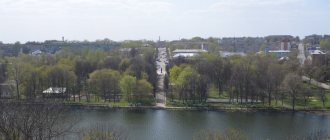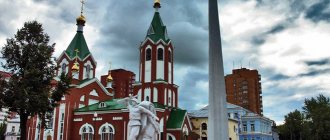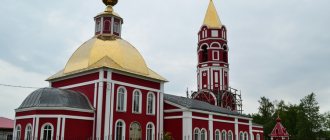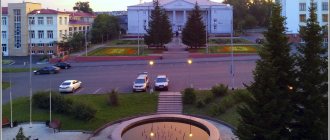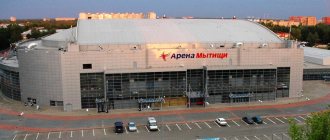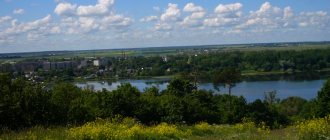The city of Danilov - attractions
The city of Danilov at the present time. This is a small town in the Yaroslavl region on the banks of the Pelenga River. Its population is only 14.5 thousand people. In the east, the Danilovsky district borders the Kostroma region.
The city is a major railway junction. There are 15 railway tracks and a junction station of different types of current - alternating and direct.
View hotels in Danilov on Booking.com =>>
Kazan Cathedral
The most significant architectural monument of Danilov. Located on the outskirts of the city. This cathedral is all that remains of the ensemble of the Kazan Convent. Founded at the end of the 19th century, the monastery constantly experienced financial difficulties. Even the construction of the main cathedral stopped for many years.
The beautiful red brick cathedral was illuminated under Soviet rule - in 1918. Now the cathedral is gradually being restored, protected by the monastic community recreated here. The temple is worth a visit to admire the architecture, unusual for the Yaroslavl land.
Details
Historical reference
The history of Danilov began in the mid-15th century. The village of Danilovskoye is mentioned in the charter of Grand Duke Vasily 2 dated 1457. According to this charter, all the Danilevo environs belonged to Jonah of Moscow, Metropolitan of All Rus'. In 1592, Danilovskaya Sloboda was already mentioned. In 1607, to fight the Poles, a militia was organized in Danilov under the command of the boyar Fyodor Sheremetev. The Poles were completely defeated in a fierce battle. The place where the battle took place is located across the Pelenga River and is now called “Povalishka”, in honor of that battle. At this place there is a worship cross and a memorial stone. In 1608, the Poles again attacked Danilov and managed to capture it in battle. The city was burned, many local residents died.
At the end of the 18th century, Danilovskaya was considered a large settlement. In the village there was a stud farm that supplied horses for the troops of Peter 1. In 1713, a stone church was built in the village - the Smolensk Cathedral. The settlement of Danilovskoye was considered a palace village. Alas, the cathedral was destroyed in 1940.
In 1777, Danilovskaya Sloboda received the status of a district town of Danilov. In 1778, the city's coat of arms was approved. A significant event in the life of the city occurred in 1870. The implementation of the project for the construction of the Yaroslavl-Vologda narrow-gauge railway and the construction of a small railway station began. Passenger train service began in 1872. Later this railway developed into a broad-gauge one.
The city gradually grew. At the end of the 19th century there were 9 factories in the city.
In 1895, a terrible fire happened in Danilov, and the city almost completely burned down. In 1918, another railway line was built. In 1935, a new railway station was built in the city, and in 1941, a woodworking machine factory was built. At that time it was the only one in the country, and its products were also exported. In 2009, the plant was declared bankrupt. As we can see from the history of the city, its best times are in the past.
View hotels in Danilov on Booking.com =>>
Danilovsky Prison Castle
Located in the center of the city. The building was built in the 19th century. Since it was constantly used and repaired until the 2000s, it was well preserved. Thanks to local historians, the prison castle is actively included in the tourist life of Danilov. Although there are no funds for its full restoration.
A visiting tourist without prior arrangement will be able to view the castle only from the outside. By calling the staff of the local history museum, you can count on a sightseeing tour of some of the premises. The guide will tell you that Alexander Solzhenitsyn was kept in the castle for some time and that in the entire history of the prison, only one prisoner escaped from it. The value of the object lies in the fact that throughout Russia there are at most two or three more such prison castles left.
Location: Yaroslavskaya street - 6.
Links[edit]
Notes[edit]
- ^ abcdefg Law No. 12-z
- ^ a b Federal State Statistics Service (2011). “All-Russian Population Census 2010. Volume 1" [All-Russian Population Census 2010, vol. 1]. All-Russian Population Census 2010 [All-Russian Population Census 2010]
. Federal State Statistics Service. - "26. The size of the permanent population of the Russian Federation by municipalities as of January 1, 2022". Federal State Statistics Service. Retrieved January 23, 2022.
- ^ abcd Law No. 65-z
- Federal State Statistics Service. Federal Agency for Technological Regulation and Metrology. No. OK 033-2013 January 1, 2014 “All-Russian classifier of municipal territories. Code 78 615.” (Federal State Statistics Service. Federal Agency for Technological Regulation and Metrology. No. OK 033-2013 January 1, 2014. Russian classification of municipal territories. Code 78 615.
). - "On the Calculation of Time". Official Internet portal of legal information
. June 3, 2011. Retrieved January 19, 2022. - Post office. Information and computing center of OASU RPO. ( Post office
).
Search for postal service objects ( postal Search for objects
) (in Russian) - ↑
Federal State Statistics Service of Russia (May 21, 2004).
“The population of Russia, the constituent entities of the Russian Federation as part of federal districts, urban settlements, settlements, settlements is 3 thousand or more people” [Population of Russia, its federal districts, federal districts, districts Urban settlements, rural settlements - administrative centers and rural settlements with a population of over 3,000] (XLS). All-Russian Population Census 2002
. - “All-Union Population Census of 1989. The current population of union and autonomous republics, autonomous regions and districts, territories, negative phenomena, urban settlements and rural district centers” [All-Union Population Census of 1989: current population of union and autonomous republics, Autonomous regions and districts , territories, regions, districts, towns and villages performing the functions of district administrative centers. All-Union Population Census of 1989 [All-Union Population Census of 1989]
.
Institute of Demography of the National Research University: Higher School of Economics [Institute of Demography of the National Research University: Higher School of Economics]. 1989 - via Demoscope Weekly
.
House of Culture
Today, perhaps, only a specialist or a very experienced lover of antiquities will be able to recognize the former temple in the house of culture of the city of Danilov. There are no domes or under-dome drums; the temple space is divided into floors.
The Resurrection Cathedral, like many churches in our country, was greatly rebuilt, but at least this saved the building from complete destruction. It is known that in 1918 Patriarch Tikhon visited it and held a service. A memorial plaque on the facade of the building tells about this.
Location: Cathedral Square - 7.
Names and dates. To the 235th anniversary of the city of Danilov, Yaroslavl province
/ Home → Press center → Publications → Names and dates. To the 235th anniversary of the city of Danilov, Yaroslavl province
The establishment of the district town of Danilov in the Yaroslavl province was the result of the administrative reform that was carried out in Russia in the 2nd half of the 18th century. On February 23, 1777, Empress Catherine II signed a decree “On the establishment of the Yaroslavl province,” the first governor-general of which was the actual privy councilor Alexei Petrovich Melgunov.
T. V. Kotova, leading researcher of the State Institution Yaroslavl Autonomous Okrug
View of the city of Danilov, Yaroslavl province. Photos of the late 19th and early 20th centuries. From the funds of the State Civil Institution Yaroslavl Autonomous Okrug.
The Yaroslavl governorship was divided into 12 districts, and one of them was Danilovsky district, part of which previously belonged to the Kostroma province. Governor A.P. Melgunov proposed to include the Danilovsky district in the Yaroslavl governorate, since, in his opinion, this territory historically and economically gravitated more toward Yaroslavl. The center of the district was the palace village of Danilovskoye, or Danilovskaya Sloboda.
A.P. Melgunov’s report to Catherine II dated July 13, 1777 states:
“From Yaroslavl, the palace department went to the village of Danilovskoye, in which the city, by all circumstances, should be. It stands on a large road from Yaroslavl leading to Vologda and the city of Arkhangelsk. There is a weekly trade there. The inhabitants, of whom it is estimated that there are 520 souls, feed mainly on trading and handicrafts, which is why many are sufficient. Of these, 72 people expressed to me their desire to be among the merchants and philistines. Moreover, it is worthy of respect that this village occupies a place in the middle of the district that should be assigned to it.”1
On August 3, 1777, Catherine II issued a personal decree to the Senate “On the establishment of the Yaroslavl governorship.” On the same day, the report of A.P. Melgunov and Lieutenant General Sivers “On the establishment of the border of the Yaroslavl governorship between the adjacent provinces and on the division of this governorship into 12 districts, with the determination of the number of souls in them,” was approved by the highest order. The viceroyalty was divided into 12 districts, including Danilovsky. It then included 967 villages, and its borders extended to the banks of the Volga. The total number of residents in the county was 64,157 people.
On August 3, 1777, the village of Danilovskoye was renamed the city of Danilov, which was designated the center of Danilovsky district2.
Governor General A.P. Melgunov, when establishing new cities from rural settlements (Danilova, Myshkina and Poshekhonya), gave instructions to the district authorities: to register local peasants, at their request and if they have the appropriate capital, as merchants or philistines. The order stated: “Submit a calculation for the newly established cities to the state peasants, how many of them there were according to the last audit, how many of them became merchants and with what capital, and the rest then declared their desire to join the philistinism. And since the inhabitants of those new cities were until now peasants, then, on the basis of this decree, from among those revision souls, some who gave their capital up to 500 rubles. and above, were registered in those cities as merchants, while others, who did not have the amount of capital for that, were renamed burghers.
In the city of Danilovsky, according to the latest audit, there were 521 male souls. Of these, 72 people want to be merchants; the declared capital is 33,145 rubles. There are 449 souls left in the philistinism, from which the payment to the treasury is 1218 rubles. 58 kopecks. From other villages, peasants declared their desire to be in the merchant class - 105, in the petty bourgeoisie - 449"3. In the list of residents of the city of Danilov, who were previously members of the Tsar’s village department, peasants were among the first to enroll as merchants and declare their capital at 500 rubles. and above, in 1778 the names appear:
- Fyodor Lukyanov son of Zhukov,
- Ivan Ivanov is the son of Krasnikovsky, he has children: Alexey and Andrey,
- Ivan Fedorov son Komatovsky,
- Ivan Ivanov is the son of Krasnikovsky, he has children: Dmitry, Ivan, Matvey,
- Ivan Ivanov is the son of Krasnikovsky, he has children: Ivan, Matvey4.
The ceremonial opening of the Yaroslavl governorship took place on December 18, 17775; officials were sent to the district cities to establish new government authorities in them, including Danilov, Lyubim and Poshekhonye - the chairman of the chamber of the criminal court, A. I. Alalykin.
The opening of public places in the city of Danilov took place on December 30, 1777.
At the end of December 1777, in Danilov, as in other district towns of the Yaroslavl governorship, meetings of townspeople were held to elect representatives to local government bodies - city mayors, merchant and town elders, verbal judges, members of city magistrates - burgomasters and ratmans.
From the report of the chairman of the Yaroslavl provincial magistrate, court councilor Kryukov, to A.P. Melgunov dated January 29, 1778:
“In fulfillment of Your Excellency’s command given to me, in the cities of this governorship, Danilov and Poshekhonye, about the residents being merchants and townspeople and about payment from this year 1778 of the dues required by law, with permission for them to trade and produce crafts, an announcement to them with subscriptions by me was carried out, and those who found themselves in number were sworn in for that new title, and in those cities the mayors and magistrates present, as well as the elders and verbal judges, were elected by balls (by voting, which was carried out by balls - comp.) by merchants and townspeople , and the selected judges were sworn in to those positions in allegiance to Her Imperial Majesty. With the consent of those societies, chambers were allocated for magistrates, orphans and verbal courts, and those public places were opened by me, and the laws that belonged to them were given ... "6.
The first mayor of the city of Danilov was the merchant Mikhail Zamorov.
The following were elected to the magistrate: merchants Ivan Kuimov and Ivan Krasilnikov as burgomasters, merchants Andrei Bolshoi Solodovnikov and Pyotr Lovygin as ratmans, and merchants Ivan Strunnikov and Gur Kuchin as burgomasters.
To accommodate these new bodies of city government in Danilov, “two chambers that were previously used for mundane zemstvo affairs were allocated: the chambers that were used to collect taxes from horses, and the second chamber under the magistrate”7.
(The magistrate was the name given to the class governing body created in cities, which had administrative and judicial functions. Before the “City Charter” of 1785, it was in charge of the city economy and administration. The magistrate’s employees were called burgomasters and ratmans. After the creation of city councils, issues of running the city economy passed to them, and the magistrates basically only had administrative and judicial functions - author's note).
Coat of arms of the city of Danilov, Yaroslavl province. Watercolor drawing from the 19th century. From the collection of the Yaroslavl provincial scientific archival commission. GKU YAO GAYAO. F. 582. Op.1. D. 377.L.9.
City of Danilov. Yaroslavskaya street. Photo from the beginning of the 20th century. From the funds of the State Civil Institution Yaroslavl Autonomous Okrug.
On June 20, 1778, the decree of Empress Catherine II “On the coats of arms of the cities of the Yaroslavl governorship” followed. In accordance with this decree, the city of Danilov received its coat of arms: “a shield cut in half at random, one half of it is silver, the other is chessboard. A bear with an ax on his shoulder emerges from the chessboard into the silver one, which means that the city belongs to the Yaroslavl governorship”8.
On March 21, 1780, the first city plan was confirmed (and then the next one on October 26, 1834).
Thus, in the 1770s. The status of the city of Danilov was determined as a district town of the Yaroslavl governorship (later - the Yaroslavl province).
The most important stage in the history of the local government apparatus of Russian cities was the formation in the 80s. XVIII century city electoral institutions.
On April 21, 1785, Catherine II signed the “Certificate of Rights and Benefits to the Cities of the Russian Empire.” For the first time in Russian history, the city was defined as an independent administrative unit with its own special rights and responsibilities, interests and needs, separate from the interests and needs of the province and the state. The charter established rights and privileges for cities, which contributed to their rapid growth, and also established elected bodies of city government.
According to the literacy, city inhabitants constituted a “city society” and enjoyed all the rights and benefits granted to the city. Townspeople received the right to manage their own public services and amenities. For this purpose, they were allowed, with the permission of the governor, to gather together once every three years. Every permanent city resident with an income of at least 50 rubles could participate in the “city meeting”. The meeting elected a general city council for a period of 3 years. The responsibilities of the City Duma included:
“To provide the residents of the city with the necessary allowance for their food or maintenance... Encourage the bringing into the city and the sale of everything that can serve for the benefit and benefit of the residents... Try to increase city revenues for the benefit of the city and for the spread of establishments by order of public charity...”.
For the permanent management of city affairs, members of the six-vote Duma were elected from six city estates: real city inhabitants, guilds, guilds, nonresidents and foreigners, eminent citizens, townspeople. It was, as it were, the executive body of city government. Both the general and six-vote Duma were chaired by the head of the city - the mayor, elected by all citizens by ballot, i.e., closed voting through points, or balls9. (The voting process consisted in the fact that everyone with the right to vote dropped a ball into a closed room - a ballot box or box: a white one, meaning a positive answer, and a black one, a negative answer - comp.). In the documents of the archival fund “Yaroslavl Viceroyal Government” there is a report of the Yaroslavl Provincial Treasury Chamber to the actual Privy Councilor, Senator, Yaroslavl and Vologda Governor-General Alexei Petrovich Melgunov dated December 11, 1785, which states that based on the provisions of the “Charter” of Catherine II on the transfer for the maintenance and development of the city economy “one percent of the profitable amount from drinking income” to the Danilovsk City Duma, when it is “established”, “seventeen rubles two kopecks and a half” will be transferred, which have already been set aside in the treasury chamber10.
Elections to the Danilov City Duma were held on December 22-29, 1785. Archival documents of the Yaroslavl viceroyal government fund for 1785 reveal an interesting fact: the first six-vote Duma of Danilov could not be drawn up for a long time, since in the newly established city there were not enough representatives from the necessary for this according to the legislation of estates.
The report to A.P. Melgunov from the Yaroslavl viceroyal government dated January 24, 1786 states:
“At the suggestion of Your Excellency, in response to the decrees sent from the viceroyal government regarding the selection of citizens according to city status to various positions, the composition of dumas, workshops and workshop councils, from the Danilov mayor, the magistrate and the mayor, it was reported that the Danilov town society, being at the council last December On the 22nd and 29th of 1785, by voting on the majority of balls, they elected to the city general duma as a member of the city council: from the city inhabitants from the guilds - Yakov Vesnik, from the townspeople - Andrei Solodovnikov, Gavril Sveshnikov and Ivan Kurzenev. As for the delivery of votes from 1st guild, out-of-towners, foreign guests and eminent citizens, there are none there, and in 2nd guild - 1st family, and then there is no one to choose from... And when electing craftsmen as magistrates, it turned out that there were different handicrafts Although there are ordinary people, there are only a small number: in the real craft there are five masters each..., only in the art of art there are no worthy five masters, and therefore no guilds have been formed, and no selection has been made from them to the city duma. For this reason, it has been determined: now in Danilov, according to the City status, there are no people worthy of the title, and there is no one to choose from. But since it is clear from the report that the six-vocal council and the blacksmith shop have not yet been formed, although there are no blacksmiths worthy of 5 masters, however, there are a number of them in the workshop, then the city mayor and the magistrate should order that in drawing up the six-vocal council, people from the blacksmith shop should be chosen, and all the chosen ones to enter into the administration of office."11
Thus, only in February 1786, a six-vote duma of 5 people was elected from the Danilovsky General City Duma to carry out the current work on city governance. The first Danilov city mayor, elected according to the “City Charter” of Catherine II, was the merchant Ivan Krasilnikov. The six-vocal Duma included vowels: from the guilds - Yakov Vesnik, from the townspeople - Andrei Solodovnikov, Gavrila Sveshnikov, Ivan Kurzenev12.
After the establishment of the governorship in 1777, a hospital was opened in Danilov, and during the period of the first city duma it was planned to open a city primary school for boys, but then they could not do this.
In 1786, misfortune befell Danilov: a terrible fire occurred that destroyed more than half of the city.
From the report of Governor General A.P. Melgunov to Empress Catherine II:
“On the night of April 23-24, a fire occurred in Danilov, which could not be extinguished due to the cramped buildings and roofs covered with thatch, and it lasted for 8 hours. 184 ordinary houses, large and small shops with edible goods - 44, without goods - burned down. 70, cellar with grape drinks - 1, old dilapidated wine cellars - 2, drinking house - 1. No harm happened to people. A fire broke out in the house of tradesman Grigory Fedorov Zzhenov...
And as this city was newly founded from a palace village, the huts for the most part were all covered with thatch, and the chimneys on the houses were wooden, and the houses were so crowded together that it was not possible to make any assistance for extinguishing, for there was a considerable wind, which from a house that caught fire... it caught fire in four places... The fire brought a loss of 58,091 rubles to the residents.”
Empress Catherine 11 donated 20 rubles for the loan to the residents who suffered devastation in that fire, “according to the number of burned-out philistine houses and merchant shops with goods, and 6 thousand 300 rubles for everything.”13.
A.P. Melgunov used the royal loan in a unique way: he began to encourage the townspeople to move their houses to the places allocated according to the confirmed plan:
“The existing philistine houses in the city of Danilov in the square and on the streets themselves, contrary to the confirmed plan, should be allocated for the construction of houses according to the plan and announce to them that whoever of them this year moves the house to the designated place will receive money from the treasury for moving it according to 20 rub. for the house."
From the money allocated, Melgunov distributed 3,700 rubles to those who suffered from the fire. The remaining 2600 rubles. he transferred his neighbor to the Yaroslavl charity home “to be given at legal interest,” which he proposed to the house to release annually from 1787 to the Danilov city magistrate for use for the maintenance of the Danilov school14.
An idea of what the city looked like after the fire is given by the “Vedomosti, the number of merchants and philistines in the city of Danilov, as well as state-owned and private buildings is listed” for 1786 from the archive fund “Governor General”:
“Merchants 2 guilds: husband. - 2. 3 guilds: men. — 43, female — 41. Philistines: husband. — 521, female - 500. Parish churches: stone - 1, wooden - 2.
State-owned buildings: newly built salt stores on a stone foundation - 2, an old store for storing salt - 1.
Particular buildings: philistine houses: stone - 1, wooden - 172, including those newly built according to the highest confirmed plan on quarter lines: stone - 1, wooden - 17, tents for storing goods, stone - 1, newly built noble houses: wooden - 3 , wooden forges - 4, tallow candle factories - 2"15.
Thus, from 1786, a system of independent city bodies and institutions of the city of Danilov began to take shape, the main tasks of which were issues of city finance and improvement. These were the first beginnings of city government.
- See: Golovshchikov K.D. The city of Danilov in the Yaroslavl province and its district. Yaroslavl, 1890. P.5.
- Complete collection of laws of the Russian Empire (hereinafter - PSZ). First meeting. T. XX. St. Petersburg, 1830. S. 503, 542, 543, 14590,14635,14637.
- GKU YAO GAYAO. F.72. Op.1. D.22. L.8-10. The original spelling is preserved in the quotations.
- GKU YAO GAYAO. F.72. Op.1. D.22. L.50. The spelling of names is given as they appear in the document.
- Dates hereinafter are given in the old style.
- Right there. L.16,19.
- Right there. L.19 vol.
- PSZ. First meeting. T. XX. St. Petersburg, 1830. P.723-724.
- Right there. T. XXII. St. Petersburg, 1830. Article 16187.
- GKU YAO GAYAO. F.77. Op.2. D.58. L.3 and vol.
- GKU YAO GAYAO. F.72. Op.2. D.1050. L.12 and vol.
- Right there. L.41.
- Right there. L.2.
- GKU YAO GAYAO. F.72. Op.2. D.1050. L.17, 21.54.
- Right there. L.42.
/ September 18, 2012
Historical and Local Lore Museum named after P.K. Sharapov
For a small town, Danilov has a surprising number of museums—as of recently, as many as three. The local history museum is the oldest, dating back to 1967. The exhibition is very rich and built according to all the canons of museum work. The visitor will learn about the nature of the region, get acquainted with the main milestones in the history of Danilov, learn about the most significant events and distinguished citizens. Much attention is paid to the heroic past and various types of crafts that existed and exist on Danilovsky land. There is a wonderful park next to the museum.
Location: Cathedral Square - 5.
Railway Junction Museum
In fact, this is a branch of the local history museum, but it has its own building and a unique collection, formed independently of the collection of the main museum. It began as a corporate museum; several years ago the collection was transferred to the local history museum. Which made the museum more accessible.
Visitors are presented with interesting exhibits from the history of the Danilov railway junction starting from the 19th century. The highlight of the museum is an old steam locomotive.
Location: Vyatskaya street - 4.
Danilovskaya Art Gallery
The gallery was founded in 1997. The collection is based on works by local artists and photographers. Not only artists from the cities of the Yaroslavl region, but also from all over the country consider it an honor to exhibit in this gallery. Visitors are constantly offered new exhibitions, excursions and master classes are held in various areas of artistic creativity. The gallery hosts a permanent exhibition and sale.
Location: Volodarsky street - 45.
Danilov
(Yaroslavl region)
OKATO code:
78215501
Founded:
1592
City since:
1777 City of district subordination (Danilovsky district, Yaroslavl region)
Center:
Danilovsky district
Telephone code (reference phone)
| 48538***** | — |
Deviation from Moscow time, hours:
0
Geographic latitude:
58°11′
Geographic longitude:
40°11′
Altitude above sea level, meters:
160 Sunrise and sunset times of the Sun and Moon in the city of Danilov
Shopping arcades
Every Russian city had shopping arcades. Danilov was no exception. In the 70s of the 19th century, the Danilovites managed to replace the old wooden shopping arcades with stone ones. They still exist in the city and are in good condition.
The local population does not have any special reverence for the monument and uses the rows for their intended purpose. There are many shops located here, which means a tourist can not only purchase local and imported goods for himself, but also freely explore the simple interiors of the Trading Rows.
General information about Danilov
The city's economy is based mainly on enterprises related to the railway, forestry and food industries. The forest is one of the main assets of the Danilovsky district - it occupies more than 51% of its territory.
The city's educational institutions include three secondary schools and the Danilovsky Polytechnic College.
During the Great Patriotic War, the city of Danilov was not damaged, so there are many wooden buildings from the century before and last. Among them there are interesting architectural and historical monuments.
St. Nicholas Church
A very interesting temple, located a stone's throw from the Trading Rows. Built in 1910, it is an excellent example of the pseudo-Russian style widespread at that time. The temple resembles more of a fairy-tale tower. It is known that a church existed on this site until the 20th century. The temple is now operational and is being gradually restored.
Location: Karl Marx street - 19a.
Chapel of the Smolensk Icon of the Mother of God
The small wooden chapel appears to be ancient, but in fact it was only built in 1998. It was the idea of Afghan veterans. They decided in this way to perpetuate the memory of the Danilov soldiers who died defending the Fatherland. Currently, the chapel is under the care of the nuns of the Kazan Monastery. There is a commemorative plaque on it.
Location: Lenin street.
Church of the Ascension
One of the few surviving temples in the city. It was built in the middle of the 19th century at the expense of the local merchant Komatovsky. The temple is operational. It is surrounded by a cemetery where the grave of the temple builder is preserved. Experts conclude that the church was built on the model of Moscow churches of the same period.
Location: Yaroslavskaya street - 26.

